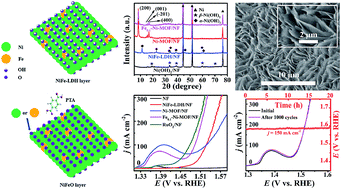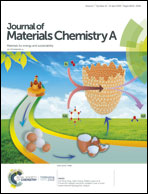Constructing a highly oriented layered MOF nanoarray from a layered double hydroxide for efficient and long-lasting alkaline water oxidation electrocatalysis†
Abstract
Metal organic frameworks (MOFs) with massive tunable periodic pores and high specific areas exceeding those of zeolites and carbon-based materials hold great promise for energy storage and conversion. In this study, we report the use of an NiFe-layered double hydroxide nanoarray on a nickel foam (NiFe-LDH/NF) as both the precursor and nanoarray template toward the in situ fabrication of a highly oriented three-dimensional (3D) MOF nanoarray (Fe0.1-Ni-MOF/NF). The as-prepared Fe0.1-Ni-MOF/NF behaved efficiently as an earth-abundant electrocatalyst for alkaline water oxidation, requiring low overpotentials of 243 and 263 mV to afford 50 and 100 mA cm−2 in 1.0 M KOH, respectively; moreover, its catalytic activity could be maintained for at least 20 h at a high current density of 150 mA cm−2. Impressively, it also achieved high turnover frequency values of 0.018 and 0.086 O2 s−1 at low overpotentials of 250 and 300 mV, respectively.

- This article is part of the themed collection: 2019 Journal of Materials Chemistry A HOT Papers


 Please wait while we load your content...
Please wait while we load your content...